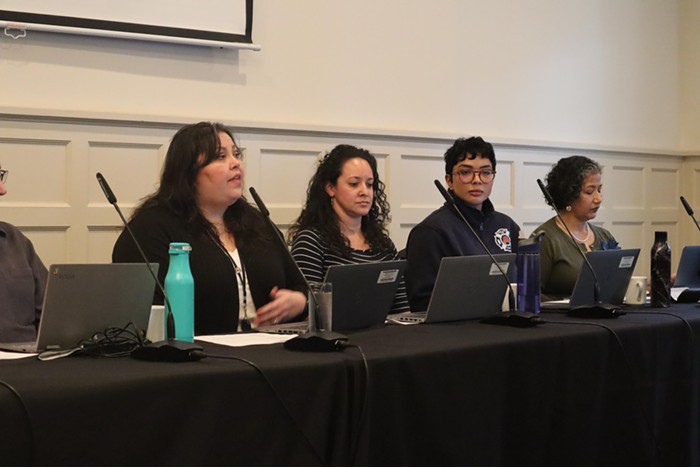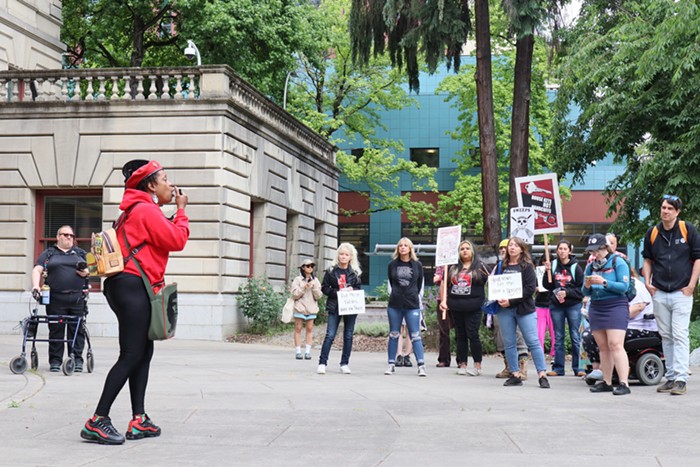IN OCTOBER of last year, city officials discovered drinking fountains in Northgate Park were discharging lead.
According to test results from the Portland Water Bureau (PWB) that were quietly posted to a city website, the Portsmouth neighborhood park’s only two drinking fountains turned up lead levels of 32.3 and 72.6 parts per billion (ppb), in excess of the 20 parts per billion “action level” set by the US Environmental Protection Agency for water in schools.
The samples, collected October 18, were among the first taken in a sweeping survey of outdoor water fixtures at Portland parks last fall. They weren’t the last to turn up elevated lead levels.
In all, the testing turned up excessive lead spouting from 12 water fixtures in nine parks throughout the city. Records of the tests were posted on a little-noticed city website, detailing lead results at dozens of city properties.
While parks officials were quick to shut off offending fountains, and even put signage on a few, some notifications to neighbors came months after tests occurred. It’s unclear how effective those notices were.
Among the findings:
• Two drinking fountains at a playground in East Portland’s Raymond Park showed results of 42.3 ppb and 40.9 ppb.
• A fountain near some tennis courts in Southwest Portland’s Gabriel Park contained 32.3 ppb.
• Water from a fountain near a baseball field at Lents Park contained 24 ppb.
• At Fernhill Park in Northeast Portland, tests on two drinking fountains—which showed lead levels at 74.3 and 36.3 ppb—led to revelations that the fountains didn’t meet plumbing code. The drinking fountain water was tapped into the same line used for watering the grass, which posed a risk of contamination. Portland Parks and Recreation (PP&R) is requesting $300,000 in next year’s budget to remedy the situation.
As you’ve likely heard time and again since elevated lead levels turned up all over Portland schools last year, no amount of lead exposure is considered safe. While the parks bureau points out there have been no documented cases of lead poisoning from drinking water in Multnomah County recently, it also notes “sustained exposure to high levels of lead can lead to serious health concerns, especially for young children.”
Which is why city parks are of potential concern: They’re frequented by kids, and there’s no telling how long problem fountains have been discharging elevated lead. PP&R spokesperson Mark Ross says the fountains had never been tested previously, and officials have yet to figure out precisely where the lead is coming from. Portland’s water is corrosive, and can leach lead from older water fixtures and pipes.
The testing conducted last year suggested the vast majority of drinking fountains and hose spigots in parks don’t merit a closer look. The 12 fixtures identified represent 3.5 percent of those tested. PP&R says an additional 53 fixtures haven’t been tested for a variety of reasons.
By using 20 ppb as a cutoff, the parks bureau is voluntarily adopting EPA guidelines. Other jurisdictions have chosen to be more restrictive.
For instance, last year Chicago shut off water fountains in parks that emitted 15 ppb of lead or more—a benchmark the EPA uses to flag problems in large public water systems rather than spot tests of individual fountains. That standard would have shut down eight additional fixtures in Portland parks.
“There is no federal, state or local regulation requiring water testing for parks facilities,” Ross notes. “PP&R management has undertaken the responsibility to create effective protocols and policies around health, safety and environmental (HSE) matters. We do not want to be a contributor to people’s exposure to lead.”
The parks bureau has clearly learned some lessons since last summer, when the Oregonian reported that officials had allowed high lead results at the Multnomah Arts Center to languish for years without proper attention.
“We haven’t had clear protocols,” Parks Director Mike Abbate told the Oregonian at the time, adding that he’d never seen the tests in question.
Now, officials are reacting more quickly. The PWB is in the midst of testing all city-owned facilities for lead, and prioritized testing parks’ outdoor drinking fountains before they were shut off for winter.
“When they had a high result for a drinking fountain, we would let [PP&R] know so they could turn that drinking fountain off,” says Scott Bradway, who runs the water bureau’s Lead Hazard Reduction Program.
But in most cases, parks officials took their time letting community members know an issue had been discovered. Only the results at Northgate prompted officials to issue a notice within two weeks. For elevated lead levels turned up between October 25 and November 30, parks officials didn’t send out word to community members until January 20 (the bureau says it received those results December 27).
And it’s unclear how effective those notices were. After getting word of the lead tests at several parks in January, the East Portland Neighborhood Office posted notices to its Facebook page, yielding little apparent interest. The office didn’t go further.
“That’s not typically the type of thing our office shares,” says Kari Koch, a community engagement coordinator with the Office of Neighborhood Involvement. “That’s parks’ job to share.”
Some neighbors didn’t even see the lead notice. Mary-Margaret Wheeler-Weber, chair of the Portsmouth Neighborhood Association, tells the Mercury she never opened PP&R’s email about Northgate.
“The subject line didn’t inspire much interest and I get a ton of informational emails,” she says.
City officials defend their efforts.
“It’s just challenging to put out a media release every few weeks,” says Bradway, of the PWB. “In buildings, we post it in the building itself. That doesn’t help with [outdoor] fountains, obviously.”
Ultimately, he argues that the lag in notifying neighbors that their kids might have been exposed to lead isn’t harmful.
“One of the challenges is that after about six weeks it’s out of your system pretty quickly,” Bradway says. “There’s also not a lot you can really do... other than remove the source of lead exposure. That’s being done instantly.”
Here's a full list of fixtures that showed elevated lead:



















